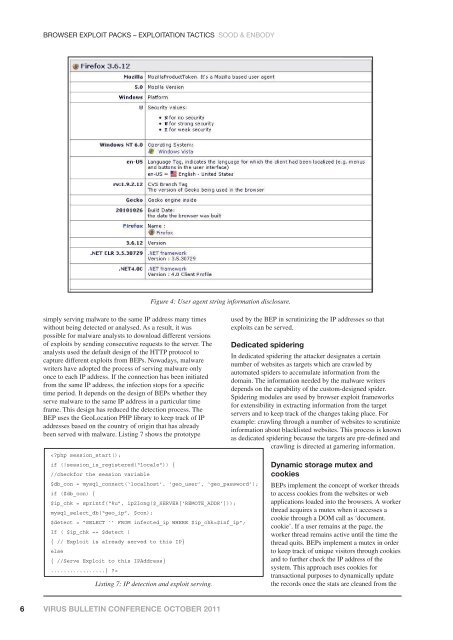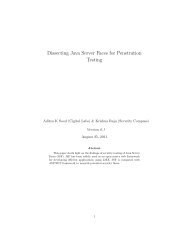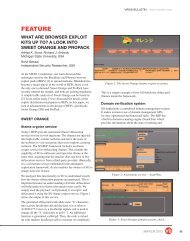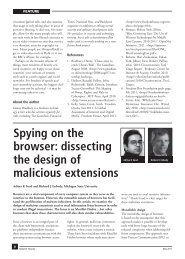browser exploit packs â exploitation tactics - SecNiche Security Labs
browser exploit packs â exploitation tactics - SecNiche Security Labs
browser exploit packs â exploitation tactics - SecNiche Security Labs
You also want an ePaper? Increase the reach of your titles
YUMPU automatically turns print PDFs into web optimized ePapers that Google loves.
BROWSER EXPLOIT PACKS – EXPLOITATION TACTICS SOOD & ENBODY<br />
simply serving malware to the same IP address many times<br />
without being detected or analysed. As a result, it was<br />
possible for malware analysts to download different versions<br />
of <strong>exploit</strong>s by sending consecutive requests to the server. The<br />
analysts used the default design of the HTTP protocol to<br />
capture different <strong>exploit</strong>s from BEPs. Nowadays, malware<br />
writers have adopted the process of serving malware only<br />
once to each IP address. If the connection has been initiated<br />
from the same IP address, the infection stops for a specific<br />
time period. It depends on the design of BEPs whether they<br />
serve malware to the same IP address in a particular time<br />
frame. This design has reduced the detection process. The<br />
BEP uses the GeoLocation PHP library to keep track of IP<br />
addresses based on the country of origin that has already<br />
been served with malware. Listing 7 shows the prototype<br />
Figure 4: User agent string information disclosure.<br />
<br />
Listing 7: IP detection and <strong>exploit</strong> serving.<br />
used by the BEP in scrutinizing the IP addresses so that<br />
<strong>exploit</strong>s can be served.<br />
Dedicated spidering<br />
In dedicated spidering the attacker designates a certain<br />
number of websites as targets which are crawled by<br />
automated spiders to accumulate information from the<br />
domain. The information needed by the malware writers<br />
depends on the capability of the custom-designed spider.<br />
Spidering modules are used by <strong>browser</strong> <strong>exploit</strong> frameworks<br />
for extensibility in extracting information from the target<br />
servers and to keep track of the changes taking place. For<br />
example: crawling through a number of websites to scrutinize<br />
information about blacklisted websites. This process is known<br />
as dedicated spidering because the targets are pre-defined and<br />
crawling is directed at garnering information.<br />
Dynamic storage mutex and<br />
cookies<br />
BEPs implement the concept of worker threads<br />
to access cookies from the websites or web<br />
applications loaded into the <strong>browser</strong>s. A worker<br />
thread acquires a mutex when it accesses a<br />
cookie through a DOM call as ‘document.<br />
cookie’. If a user remains at the page, the<br />
worker thread remains active until the time the<br />
thread quits. BEPs implement a mutex in order<br />
to keep track of unique visitors through cookies<br />
and to further check the IP address of the<br />
system. This approach uses cookies for<br />
transactional purposes to dynamically update<br />
the records once the stats are cleaned from the<br />
6 VIRUS BULLETIN CONFERENCE OCTOBER 2011












